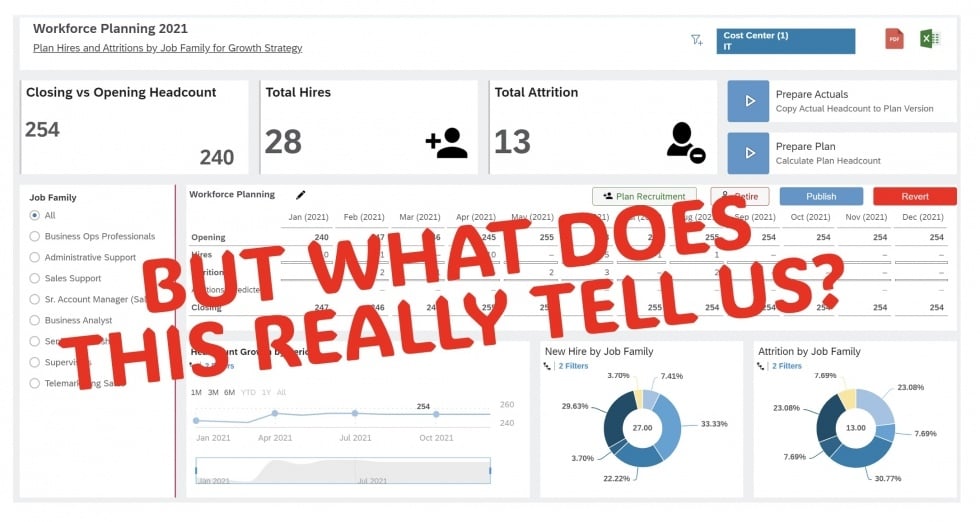Simplifying Workforce Planning: Practical Tips for HR Leaders

By Linda Brenner | January 28, 2025
You’d be hard pressed to find business or HR leaders who think that workforce planning is not a necessary tool for identifying talent-related priorities and necessary investments. With tools like Visier and Tableau, HR teams can access a treasure trove of data instantly, anytime. But here's the kicker: while the data might seem easy to grab, deciphering its true meaning and turning it into actionable plans is the real challenge. In fact, slick dashboards and simple reporting tools can actually make the problem worse when we assume that all the work is being done for us.
It’s like sifting through a mountain of puzzle pieces to find the ones that actually matter. Attrition rates, tenure distributions, and critical role vacancies aren't just buzzwords; they're the keys to unlocking your workforce's potential. So, forget the formalities and dive into the data jungle – because mastering it is the difference between reactive firefighting and proactive strategic planning.
Let’s face it - knowing, monitoring and improving on just a few basic metrics such as attrition for key roles or locations, early attrition rates and internal mobility data by role, can inform much of the roadmap for HR. Don’t have benchmarks to compare yourself to? Don’t worry about it - the best benchmark is constantly (even incrementally) improving on your own baseline.
Workforce planning can often seem daunting, but getting started can be simple. In fact, the most crucial insights for effective planning should come from basic payroll data and the good news is . . . it’s usually accurate! By following these tips, you can create an actionable, directionally-accurate view of your build / buy / borrow needs. By reviewing and updating it quarterly, you can constantly refine and improve it.
Here is a 6-step roadmap to build a simple workforce plan right now and begin aligning it with HR priorities and investments for the balance of 2024 and beyond:
- Start with the Basics: Begin by harnessing payroll data to identify key workforce trends such as attrition rates, tenure distribution, and role types across different locations. By focusing on fundamental metrics, HR leaders can gain valuable insights into staffing dynamics without getting bogged down by unnecessary complexities.
- Segment for Precision: Overall attrition is often meaningless (“We have 42,000 employees and our attrition rate is 6%.”) because it obscures the fact that some (even critical) roles might be experiencing a very high turnover rate while others quite low. Perhaps low turnover is not the goal for some organizations or roles either. A more powerful and actionable view of turnover focuses on level, verticals, geographies, key roles, contingent workers, etc. - all of which requires data analysis. Segment your workforce based on role criticality and availability in the talent marketplace to zero in on the positions that are most essential to your enterprise commitments. From there, analyze attrition based on tenure by role type in order to pinpoint areas of vulnerability and prioritize hiring, internal mobility and/or retention efforts accordingly.
- Then Cut by Location: Take into account regional variations in attrition and staffing attrition and requirements to tailor your workforce plan accordingly. By examining attrition rates by location, you can allocate the resources you need to ensure minimal gaps or interruptions in both labor and intellectual capital.
- Use the Data to Make Decisions: It might sound obvious, but drive agreemment among HR leaders and key stakeholders that strategic workforce decisions will be made using workforce data. While plans may initially be 80% accurate, their accuracy will imrpove over time. But until we commit to using them in concrete ways - reducing early attrition among IT professionals, improving retention through career development for district managers, reducing new hire day one no-shows, etc. - and taking action and evaluating our progress, they will just end up in a (virtual) drawer.
- Make it Iterative: View workforce planning as an iterative process that evolves over time. Review your assumptions and plans on a quarterly basis. As stakeholders become more engaged and additional data sources are integrated into the planning process, the accuracy of workforce projections will improve, enabling HR leaders to refine their strategies and optimize resource allocation.
- Collaborate with Others: Foster collaboration across departments to enhance the effectiveness of workforce planning efforts. By involving key stakeholders such as finance, operations, and senior leadership in the planning process, HR leaders can lead the effort of gaining more insights, building more accurate plans, and ensuring an understanding the workforce implications of future business plans. For there, objectives can be aligned, workforce insights and plans improved and buy-in secured for proposed strategies.
By adopting a practical yet systematic approach to workforce planning, HR leaders can navigate the workforce complexities of 2024 and beyond with greater confidence and efficiency. By leveraging basic payroll data and implementing these tips, organizations can develop robust workforce plans that lay the foundation for sustainable success in 2024 and beyond.

Email Updates
Get notified when we update our blog.
Learn More
Not All Employees Are Equal: The Importance of Strategic Human Resource Management
Read ThisLearn more about our unique approach to Talent Strategy Formulation.
Our Bloggers

Linda Brenner
Linda is an industry vet with keen observations and a knack for calling it like it is.

Tom McGuire
Tom brings the unlikely blend of Finance & HR to the practice, illuminating readers with the link between talent and business value.